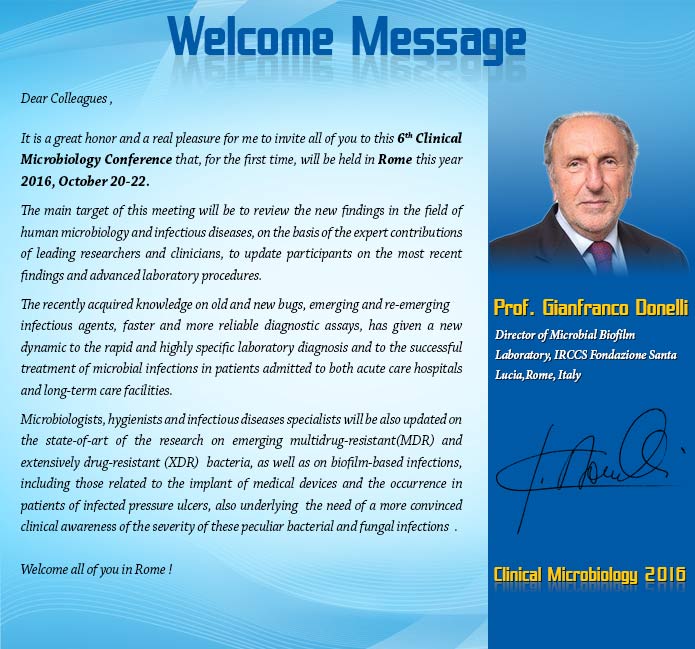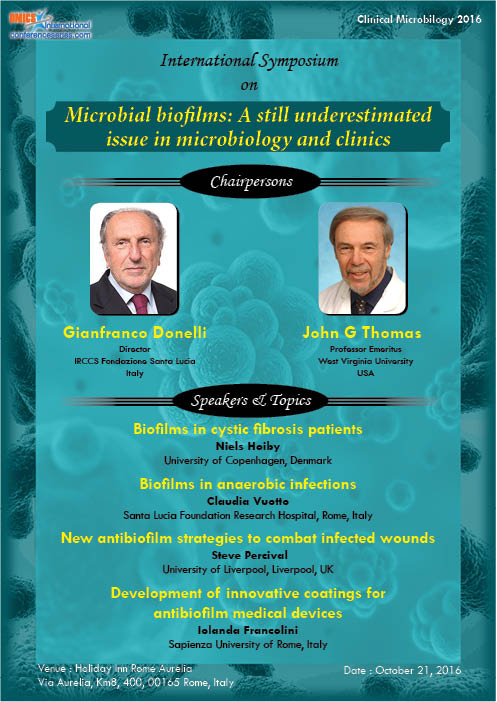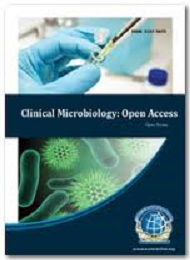Theme: One Health: To attain optimal health for people, animals and the environment
Clinical Microbiology 2016
- Welcome Message
- Workshop/ Symposia
- About Conference
- Market Analysis Report
- Session/Tracks
- Scope And Importance


After the success of Clinical Microbiology 2012, Clinical Microbiology 2013 and with the tremendous response of Clinical Microbiology 2014 and Clinical Microbiology 2015 ,OMICS Group International is glad to announce 6th International conference on Clinical Microbiology & Microbial Genomics (Clinical Microbiology-2016) during October 24-26, 2016 at Rome, Italy.
OMICS International Organises 300 International Conferences Every Year across USA, Europe & Asia with support from 1000 more scientific societies and Publishes 500+ Open access journals which contains over 50000 eminent personalities, 50,000 reputed scientists as editorial board members and 5 million readers.
This meeting will focus in particular on the most current research related to the laboratory diagnosis of human and animal infections and the role of the laboratory in both the management of infectious diseases and the elucidation of the epidemiology of infections, the latest developments in clinical microbiology and immunology, providing the current state of knowledge in the field, as well as balanced, thought-provoking perspectives on controversial issues.
Why to attend?
- Best platform to develop new partnership & collaborations.
- Best location to speed up your route into every territory in the World.
- 89% our conference attendees are the Key contact in their labs purchasing decisions.
- Our exhibitor booths were visited 4-5 times by 80% of the attendees during the conference.
- Past exhibitor’s feedback reveals ample of enquiries perceived from the conference attendees.
- Network development with both Academia and Business.
Target Audience:
We invite experts in the field of clinical microbiology including bacteriologist, virologist, molecular microbiologist, infection and quality control clinicians, exercise physicians, yoga practitioners, veterinary microbiologist and delegates from industries focusing on microbiology, molecular genomics and industrialist involved in biomedical research as well.
Market analysis: Clinical Microbiology-2016
Clinical Microbiology 2016 is an opportunity or a platform to focus and analyze recent innovations and challenges in the field of Clinical Microbiology and Microbial Genomics. Thus contributing both academicians and business partners to grow and spread their research and products respectively. Clinical Microbiolog-2016 welcomes attendees, presenters, and exhibitors from all over the world to Rome, Italy on October 20-22, 2016.
Clinical microbiology is a branch of medicine concerned with the prevention, diagnosis and treatment of infectious diseases caused by four kinds of microorganisms i.e. bacteria, fungi, parasites and viruses. In addition, this field of science studies various clinical applications of microbes for the improvement of health.
The Global microbiology market is growing due to increase in prevalence of pathogenic diseases, growth in discovery of mutating and adapting bacterium, and the growing need for speedy microbiological testing methods. In Rome there are 414 researchers and many Societies, Associations are related to Microbiology and Microbial genomics. On the basis of geography, the clinical microbiology, Europe holds the second place in the global market in the field of Clinical Microbiology and microbial genomics. The market growth is expected to reach $ 65 billion by 2024 in Europe. In Europe countries like UK, France, and Germany are possessing good market share in the field of microbiology and infectious diseases. Spain and Italy are the emerging market trends for clinical microbiology in Europe. As per the scope and emerging market for Clinical Microbiology and genomics Rome has been selected as Venue for the 5th International Conference on Clinical Microbiology and Microbial genomic. Clinical Microbiology-2016 provides you with an exceptional format to showcase services and the scientific program paves a way to gather visionaries through the research talks and presentations and put forward many thought provoking strategies on Clinical Microbiology-2016.
There are around 50 major universities in Philadelphia: Sapienza - Università di Roma, Roma Tre University, Guglielmo Marconi University, Pontifical Gregorian University and University Magna Graecia to name a few whose research interest range from the genetic basis of drug resistance in protozoan parasites to the mathematical modeling of helminth transmission within host populations and understanding immune regulation in hosts infected with Leishmania, Toxoplasma, and molecular parasitology in which investigators study drug resistance in toxoplasmosis, gene regulation and understanding basic molecular functioning of parasites to develop new antimicrobial drugs.
Trends in Molecular microbiology diagnostic market :
Conference Highlights:
- Insights and Trends In Microbiology
- Clinical Bacteriology
- Clinical Virology
- Parasitology and Mycology
- Clinical Veterinary Microbiology
- Clinical Immunology
- Microbial Genomics and Cellular Microbiology
- Genome Plasticity and Infectious Diseases
- Vaccines against Infectious Diseases
- Microbial and Biochemical Technology
Why to attend?
- Best platform to develop new partnership & collaborations.
- Best location to speed up your route into every territory in the World.
- 89% our conference attendees are the Key contact in their labs purchasing decisions.
- Our exhibitor booths were visited 4-5 times by 80% of the attendees during the conference.
- Past exhibitor’s feedback reveals ample of enquiries perceived from the conference attendees.
- Network development with both Academia and Business.
A Unique Opportunity for Advertisers and Sponsors at this International event:
http://clinicalmicrobiology.conferenceseries.com/sponsors.php
History of Clinical Microbiology Research
In 1676, Anton van Leeuwenhoek observed bacteria and other microorganisms, using a single-lens microscope of his own design. In 1796, using an ancient Chinese technique for smallpox vaccination, Edward Jenner developed a method using cowpox to successfully immunize a child against smallpox. The same principles are used for developing vaccines today. Following on from this, in 1857 Louis Pasteur also designed vaccines against several diseases such as anthrax, fowl cholera and rabies as well as pasteurization for food preservation. In 1867 Joseph Lister is considered to be the father of antiseptic surgery. By sterilizing the instruments with diluted carbolic acid and using it to clean wounds, post-operative infections were reduced making surgery safer for patients. In the years between 1876-1884 Robert Koch provided much insight into infectious disease. He was one of the first scientists to focus on the isolation of bacteria in pure culture. This gave rise to germ theory, a certain microorganism being responsible for a certain disease. He developed a series of criteria around this that have become known as the Koch's postulates’ major milestone in medical microbiology is the Gram stain. In 1884 Hans Christian Gram developed the method of staining bacteria, to make them more visible and differentiable under a microscope. This technique is widely used today.
Members Associated with Clinical Microbiology Research In Rome, Italy:
There are around 50 major universities in Rome: Sapienza - Università di Roma, Roma Tre University, Guglielmo Marconi University, Pontifical Gregorian University and University Magna Graecia to name a few whose research interest range from the genetic basis of drug resistance in protozoan parasites to the mathematical modeling of helminth transmission within host populations and understanding immune regulation in hosts infected with Leishmania, Toxoplasma, and molecular parasitology in which investigators study drug resistance in toxoplasmosis, gene regulation and understanding basic molecular functioning of parasites to develop new antimicrobial drugs.
Rome Hospitals with Clinical Microbiology
- Rome American Hospital Srl
- Salvator Mundi International Hospital
- Ospedale Sandro Pertini
- Azienda Ospedaliera S. Giovanni
- Chestnut Hill Hospital
- European Hospital
- Ospedale Santo Spirito
Major Clinical Microbiology Associations in & around Rome, Italy
- European Society of Clinical Microbiology and Infectious Diseases
- Federation of European Microbiological Society
- Society General Microbiology
- Italian Society of Parasitology
- European Society for Virology
- International Retro virology Association
- European Federation of Parasitologists
Target Audience:
We invite experts in the field of clinical microbiology including bacteriologist, virologist, molecular microbiologist, infection and quality control clinicians, exercise physicians, yoga practitioners, veterinary microbiologist and delegates from industries focusing on microbiology, molecular genomics and industrialist involved in biomedical research as well.
Universities in Italy:
- St. John's University
- Sapienza - Università di Roma
- Università di Bologna
- Università degli Studi di Milano
- Università degli Studi di Padova (UNIPD)
- Universitá degli Studi di Roma - Tor Vergata
- Università di PisaTufts
- Università degli Studi di Siena
- University Magna Graecia
Top Life Science Companies in Italy:
- Pfizer
- Recordati
- MolMed
- Menarini
- Patheon
- Baxter
- Silicon Biosystems
- Roche
- Procus (CBC)
- AbbVie
- Allergan
- Bayer
Recent sales report of Clinical Microbiology:
References:
http://www.strategyr.com/Automated_And_Rapid_Microbiological_Tests_Market_Report.asp
http://www.idsociety.org/Research_and_Funding_Opportunities/
http://www.transparencymarketresearch.com/microbiology-culture-market.html
http://www.grandviewresearch.com/industry-analysis/clinical-laboratory-services-market
http://www.cdc.gov/flu/antivirals/index.htm
http://www.niaid.nih.gov/topics/antimicrobialresistance/Pages/default.aspx
Clinical Microbiology-2016 ardently encourages patrons, benefactors, pioneers, and exhibitors from across the world to convene you all to attend and register for the “6th Clinical Microbiology Conference (Clinical Microbiology 2016) which is going to be venerated from October 20-22, 2016 at Rome, Italy.
The organizing committee is endowing for a rather stimulating and illuminative conference programs subsuming Plenary Lectures, Symposia, Workshops on a myriad of topics, Poster Presentations and an assortment of programs for participants from over the globe. We invite you to accompany us at the 6th Clinical Microbiology-2016, where you are assured to have a substantially worthwhile experience with ecumenical scholars. All the representatives of Clinical Microbiology-2016 organizing committee look forward to meet you at the congregation at Rome, Italy.
The immune system is a rather circuitous system of interaction of cells to discern foreign substances cited as antigens. The immune system proffers protection from various infections. Due to a variation in its forms, immune responses are obliged to deal with every category of infection. Vaccination is the utmost effectual approach of prevention of innumerable diseases; immunity due to vaccination is agile for eradication of smallpox and diminishing the effects of many other diseases like instance, polio, measles, and tetanus especially in the developing countries. There are also those vaccines, which are administered only after the patient has contracted a disease; Like for instance, vaccines for smallpox are administered only after exposure to smallpox- When given during first three days, patients are found to attenuate the disease, while vaccination given after a week of exposure disburses some protection from the said disease. The aboriginal rabies immunization was conferred to a child by Louis Pasteur succeeding the bite from a rabid dog. It has been found that, in people with undiminished immune system, four doses of rabies vaccine for 2 weeks, wound healing and therapeutic aiding of bite with rabies immune-globulin, when started immediately after exposure helps in preventing rabies in humans. Few examples include immunizations for experimental AIDS, cancer and Alzheimer's. The intent of such immunizations is to trigger a rapid immune response with decreased side-effects and harm as that of the natural infection.
After resumption from the relentless economic debacle of 2008, European Countries have made substantial investments in the health care R&D (research and development). This would probably boost the microbiology industry growth rate throughout the forecast period of 2015 to 2023.
Related Microbiology Conferences | Clinical Microbiology Conferences | ConferenceSeries Ltd
6th Clinical Microbiology Conference, October 20-22, 2016 Rome, Italy; International Conference and Expo on Industrial Microbiology August 01-03, 2016 Frankfurt; European Microbiology Conference August 04-06, 2016 Frankfurt, Germany; 2nd International Conference on Parasitology August 01-03, 2016 Manchester, UK; International Conference on Mycology September 12-14 San Antonio, USA; 26th European Congress of Clinical Microbiology and Infectious Diseases (ECCMID 2016) June 16-20, 2016 Boston, USA; Anaerobe 2016 July 11-14,2016 Nashville, USA; Microbe 2016, September 23-25, 2016 Sheffield, UK
The analysis of the molecular and cellular viscera constituting the immune system, subsuming their function and interaction, is the pivotal science of immunology. Autoimmune diseases are an expansive spectrum of analogous diseases in which the immune system produces an erroneous retroaction against privy cells, tissues and/or organs, ensuing inflammation and damage. There are furthermore 80 different autoimmune diseases ranging from commonly prevalent to very discreet diseases. Cell-based immunotherapies are validated to be competent for some cancers. Immune effector cells for instance, Macrophages, Lymphocytes, Natural Killer cells (NK Cell), Dendritic cells, Cytotoxic T Lymphocytes (CTL) etc., work collectively to shield the body against cancer by directing the encounter on deviant antigens expressed superficially on the tumor owing to mutation. Allergies and sensitivities have augmented exorbitantly in the recent interim — Acute, Chronic and Subclinical Allergies have been intensified so radically that estimates are that over 60 million Americans have various allergies and few more millions suffer from sensitivities.
As implied by the U.S Centre for Disease Control and Prevention (CDC) the Respiratory syncytial infection (RSV) is the primary reason for bronchiolitis &/or pneumonia in the children under one in the United States. Each year 75,000 to 125,000 kids on an average are hospitalized because of RSV diseases.
Related Microbiology Conferences | Clinical Microbiology Conferences | ConferenceSeries Ltd
6th Clinical Microbiology Conference, October 20-22, 2016 Rome, Italy; International Conference and Expo on Industrial Microbiology August 01-03, 2016 Frankfurt; European Microbiology Conference August 04-06, 2016 Frankfurt, Germany; 2nd International Conference on Parasitology August 01-03, 2016 Manchester, UK; International Conference on Mycology September 12-14 San Antonio, USA; 26th European Congress of Clinical Microbiology and Infectious Diseases (ECCMID 2016) June 16-20, 2016 Boston, USA; Anaerobe 2016 July 11-14,2016 Nashville, USA; Microbe 2016, September 23-25, 2016 Sheffield, UK
Microbial Pathogenesis
Pathology is an interdisciplinary of medical science comprising the observation of organs, tissues, and other body fluids to diagnose a disease. It is a principal field in contemporary medical implementation and health care. Pathology abridges the plight of the disease and the treatment required and prognosis by merely using laboratory techniques; which are primarily used in the diagnosis and treatment of an elevating spectrum of clinical conditions. Pathology investigations are an indispensable part of the clinical treatment and diagnostic approaches with estimates indicating about 70-80% of all treatment approaches depend on these pathological investigation. Clinical Pathology is a medical forte, which is pertinent to the diagnosis of a disease contingent to the laboratory analysis of bodily fluids. Molecular pathology is another inter-disciplinary field of pathology devising few practices with drug development and various treatment strategies. It is a sub-discipline of pathology which studies ailments by auditing of samples of organs, tissues or body fluids. It is multifarious and concentrates primarily on minute elements of these diseases. More precise diagnosis is achievable when the diagnosis is based on the morphologic modifications in tissues and on molecular testing in diseases like cancer. Molecular pathology is very useful sub-field in drug development and treatment of cancer.
Clinical Trial Management System (CTMS) Market : The Global Industry Analysis, Share, Size, Trends, Growth and Forecast, reports that the CTMS market, which was worth US$844 million in 2013 will elevate at a CAGR of about 14% between 2013 and 2019 to acquire a net worth of an envisaged US$1,848.5 million by 2019.
Related Microbiology Conferences | Clinical Microbiology Conferences | ConferenceSeries Ltd
6th Clinical Microbiology Conference, October 20-22, 2016 Rome, Italy; International Conference and Expo onIndustrial Microbiology August 01-03, 2016 Frankfurt; European Microbiology Conference August 04-06, 2016 Frankfurt, Germany; 2nd International Conference on Parasitology August 01-03, 2016 Manchester, UK; International Conference on Mycology September 12-14 San Antonio, USA; 26th European Congress of Clinical Microbiology and Infectious Diseases (ECCMID 2016) June 16-20, 2016 Boston, USA; Anaerobe 2016 July 11-14,2016 Nashville, USA; Microbe 2016, September 23-25, 2016 Sheffield, UK; MicroBiotec15, December 10-12, 2015 Evora, Portugal; Advances in Nematology December 15, 2015 London, United Kingdom.
Nosocomial Infections
Nosocomial Infection comprises infection which is struck from the hospital surroundings, staff, in-patients/out-patients, cleaners and other healthcare centers. These infections can be contracted in any of the health-care departments like- the Hospital environment or the Nursing Home, Rehabilitation Centers or other Clinical settings. Nosocomial Infections are relayed to the pre-disposed in such environments by an innumerable ways. Various Health care personnel can spread different infections via contaminated equipment, Soiled/unclean/non-disinfected bed linens and other clothes, blankets, pillows, or air droplets. These infections can spread either from outside of the hospital, from in-patient, staff that may be infected, or carriers, unknown sources. In most of the pathogenic microorganisms originate from the patient's own skin flora, also called as opportunistic microbes; after any surgical process or those procedures that compromises skin as the primary protective barrier. Albeit, the patient contracts the infection privy from their skin, the infection are considered to be nosocomial since it emanates in the hospital.
Hence Hospitals have strict sanitation protocols with reference to staff uniforms, disinfection, sterilization of all equipment, hand sanitization, among other preventive measures. Appropriate hand-wash or alcohol use by medics before and after patient contact is the primary and one of the most effectual ways to prevent nosocomial infections. Furthermore scrupulous use of antimicrobial agents, for instance antibiotics, is indispensable in preventing nosocomial infections.
The Global Stem Cell Therapy Industry, is envisaged to grow at a high rate of about 39.5% CAGR in the forecast period of 2015 to 2020 to acquire the net worth of $330million by 2020.
Related Microbiology Conferences | Clinical Microbiology Conferences | ConferenceSeries Ltd
6th Clinical Microbiology Conference, October 20-22, 2016 Rome, Italy; International Conference and Expo onIndustrial Microbiology August 01-03, 2016 Frankfurt; European Microbiology Conference August 04-06, 2016 Frankfurt, Germany; 2nd International Conference on Parasitology August 01-03, 2016 Manchester, UK; International Conference on Mycology September 12-14 San Antonio, USA; 26th European Congress of Clinical Microbiology and Infectious Diseases (ECCMID 2016) June 16-20, 2016 Boston, USA; Anaerobe 2016 July 11-14,2016 Nashville, USA; Microbe 2016, September 23-25, 2016 Sheffield, UK
A crucial element in an accomplished entrepreneurship is self-knowledge. Clinical Microbiology-2016 intends to en masse all bio entrepreneurs – de facto and budding, to construe the experiences and latest innovations and challenges in the present microbiological research. Annually, over a million start-ups are seen globally with about 5–10, being classified as high-tech/ futuristic companies, turning mind maps into business ventures is precarious and the crucial step is the opportunity-recognition step in any given new venture creation. This contour in the entrepreneur's approach of the co-relation between invention and eventual product is then genteel moulded into a business prototype that specifies how the endeavor will gain finances or provide adequate returns to the probable stockholders. Biological science is an intricate and expeditiously changing and beseeches a characteristic knowledge to apprehend the essence of the innovation and its ambitious position in the industry. Although scientists are the founders of biotech organizations, surveys have shown that the most successful hi-tech startups are headed by a team of two/ three individuals with eclectic backgrounds, profuse industrial experience and a coherent market and product target at organizing. This three day inter-disciplinary conference will be eminently interactive & will en masse elites in fields of Structural Microbiology to Signaling Pathways to Novel Therapeutic Approaches. Additionally, congress meet will also have short talks and poster presentations. This session avant-garde Synthetic Biology research to accentuate the prevailing stipulations, predicament and the prospective engineered microbial communities advancement.
Infection Control
Infection control is the forestalling/prevention of nosocomial infections. It is a part of the framework of the health care. Infection Control and Hospital Epidemiology are pertinent to the public health practice, interpolated in a particular health-care distribution system. Anti-infective agents, like for instance antibiotics - essentially antibacterial, antiviral, antifungal and antiprotozoal are readily accessible to annihilate infections. Infection control comprises elements relevant to the transmission of infections; either in the hospitals or other healthcare centers including prevention via hand hygiene, cleaning or disinfection or sanitization, vaccines or surveillance and probe of infections in a health-care domain and management. Sterilization kills all microorganisms- live or dominant. Sterilizers are categorized in heat, steam and liquid categories. Disinfection is wiping / killing of the live micro-organisms at room temperatures. Ultraviolet light (UV Light) is also used to sterilize the rooms of infected/ pre-disposed patients after discharge.The essential factor is that disinfection is less effective than sterilization because disinfection does not harm bacterial spores or dominant bacteria. Personal Protective Equipment (PPE) is few protective gears to be worn for protection against hazards of sterilizations or while using equipment. The primitive hazards in any given healthcare comprises of blood, saliva, other body fluids or aerosols that carry infectious agents like Hepatitis C, HIV, and other blood borne or fluid pathogen. PPE helps preventing contact with a potentially infectious agent by framing a physical barrier between the potential infectious agent and the healthcare professional.
The Global Infectious Disease industry is envisaged to reach $8.8 billion by 2017, growing at a compound annual growth rate (CAGR) of about 6% from 2010.
Related Microbiology Conferences | Clinical Microbiology Conferences | ConferenceSeries Ltd
6th Clinical Microbiology Conference, October 20-22, 2016 Rome, Italy; International Conference and Expo onIndustrial Microbiology August 01-03, 2016 Frankfurt; European Microbiology Conference August 04-06, 2016 Frankfurt, Germany; 2nd International Conference on Parasitology August 01-03, 2016 Manchester, UK; International Conference on Mycology September 12-14 San Antonio, USA; 26th European Congress of Clinical Microbiology and Infectious Diseases (ECCMID 2016) June 16-20, 2016 Boston, USA; Anaerobe 2016 July 11-14,2016 Nashville, USA; Microbe 2016, September 23-25, 2016 Sheffield, UK
Parasitic Diseases
Study of the interaction of the parasite and their hosts is Parasitology. Medical parasitology has it’s congruence with the pathogenic parasites affecting humans, the diseases, clinical pathology and the response of the human’s immune system against these pathogens. It also deals with the different approaches of the infection and diagnosis, treatment, prevention & control. Additionally medical parasitology also comprises of Drug Development, Epidemiological Studies and zoonosis. An interdisciplinary field, inveigled by Biochemistry, Immunology, Microbiology, and other applied life sciences. Parasites inhabit the host of a remarkably high immuno-potent immune system. Vector-borne infections are transferred via bite of an infected arthropod, for instance mosquitoes, ticks, bugs, sandflies and blackflies. Resistant parasitic worms developed resistance against other infectious agents although the mechanisms of resistance in protozoan parasites are not yet acknowledged. About 50% of known positive malarial cases are caused by P. vivax. Prevailing advancements in state-of-the-art diagnostic tools has ascertained new facets for colossal enhancements in parasitic detection. Control and dissolution of human parasitic diseases require innovative outlooks, notably in the fields of diagnostics, modeling, investigation, interpretation, scrutiny and public health response.
The Global Animal Healthcare industry was venerated at US $27,861.2 million in 2013 and is envisaged to grow at a CAGR of about 7.1% to achieve an anticipated US $41,929.1 million by 2019.
Related Microbiology Conferences | Clinical Microbiology Conferences | ConferenceSeries Ltd
6th Clinical Microbiology Conference, October 20-22, 2016 Rome, Italy; International Conference and Expo onIndustrial Microbiology August 01-03, 2016 Frankfurt; European Microbiology Conference August 04-06, 2016 Frankfurt, Germany; 2nd International Conference on Parasitology August 01-03, 2016 Manchester, UK; International Conference on Mycology September 12-14 San Antonio, USA; 26th European Congress of Clinical Microbiology and Infectious Diseases (ECCMID 2016) June 16-20, 2016 Boston, USA; Anaerobe 2016 July 11-14,2016 Nashville, USA; Microbe 2016, September 23-25, 2016 Sheffield, UK
Fungal Diseases
Mycology is a Biological discipline comprising the study of fungi, their frame-work, their genetic and biochemical characteristics, taxonomy and their benefits especially as a primary source of wine, edible mushrooms, cheese, and their adverse effects with respect to their toxin or infection. Fungi and other organisms such as oomycetes and myxomycetes, often are economically crucial, as the pathogenic fungi affects animals by causing diseases like histoplasmosis. Recent studies asserts that mushrooms have hypoglycemic, immune system-enhancing, anti-pathogenic and anti-cancer activity. Food spoilage induced by fungi and yeasts can be more compelling, notably in innumerable food groups particularly that are acidic and/or have low moisture content. Mycotoxicology is a sub-branch focusing on toxins produced by fungi, called mycotoxins. Fungi have an important role in the ecosystem as they break down and eventually decompose dead plants, animals and other organic matter; while some destructive fungi attack living organisms resulting in casualties to the forest industry. Fungi are also a discrete source of food, fuel, pharmaceuticals and pesticides. Being eukaryotes, fungi are an essential tool in various biotechnological applications and in bioremediation.
The Global Healthcare industry was at its peak at USD 27,861.2 million in the year 2013 and is anticipated to grow at a CAGR of 7.1% to attain estimated USD 41,929.1 million by 2019.
Related Microbiology Conferences | Clinical Microbiology Conferences | ConferenceSeries Ltd
6th Clinical Microbiology Conference, October 20-22, 2016 Rome, Italy; International Conference and Expo onIndustrial Microbiology August 01-03, 2016 Frankfurt; European Microbiology Conference August 04-06, 2016 Frankfurt, Germany; 2nd International Conference on Parasitology August 01-03, 2016 Manchester, UK; International Conference on Mycology September 12-14 San Antonio, USA; 26th European Congress of Clinical Microbiology and Infectious Diseases (ECCMID 2016) June 16-20, 2016 Boston, USA; Anaerobe 2016 July 11-14,2016 Nashville, USA; Microbe 2016, September 23-25, 2016 Sheffield, UK
Viral Infections
Viral infections are quite prevalent, most typically seen are the common cold, hepatitis, influenza, measles, rabies, Dengue, diarrhea, AIDS , polio, smallpox, cold sores and genital herpes, Study of various ways through which viruses affect individuals are specified as viral pathogenesis. The purview of the disease/ infection caused by the virus is its virulence. When a virus invades into the host, the immune system starts producing specific/ impromptu antibodies that binds to the virus thereby neutralizing its virulence or kills them. Presence of such antibodies in blood serum detects if a host has ever been exposed to any given virus in the past. This is possible only with the help of specific tests such as ELISA. Vaccinations protect against diseases, by augmenting the production of antibodies. Monoclonal antibodies, are profoundly specific to a single virus, are typically used for detection in fluorescence microscopy. Additionally, viruses being used as gene vectors in the gene therapy of genetic diseases are also gaining momentum; similarly in phage therapy, use of the bacteriophages to encounter bacterial infections and diseases was effectual. The recent approach of genetically engineered viruses in nanobiotechnology is seen as the novel approach to combat various diseases at the genetic level.
Due to the rampant HCV infection and high insistence for such enhanced and effectual treatments, numerous estimates envisage the global industry for HCV treatment costs $20 billion annually, this decade.
Related Microbiology Conferences | Clinical Microbiology Conferences | ConferenceSeries Ltd
6th Clinical Microbiology Conference, October 20-22, 2016 Rome, Italy; International Conference and Expo on Industrial Microbiology August 01-03, 2016 Frankfurt; European Microbiology Conference August 04-06, 2016 Frankfurt, Germany; 2nd International Conference on Parasitology August 01-03, 2016 Manchester, UK; International Conference on Mycology September 12-14 San Antonio, USA; 26th European Congress of Clinical Microbiology and Infectious Diseases (ECCMID 2016) June 16-20, 2016 Boston, USA; Anaerobe 2016 July 11-14,2016 Nashville, USA; Microbe 2016, September 23-25, 2016 Sheffield, UK
Bacterial diseases constitutes infections whose essential causative organism is bacteria. In bacterial pathogenesis the bacteria infects and causes a disease in the host whose cell it invaded in. However, not all bacteria are pathogenic and they have the ability to cause a disease. Bacteria also resides in host without harming it in a symbiotic relation and also helps in building a response against the invading foreign opportunistic bacteria from harming the host. Bacteria primarily produce two types of toxins called the Exotoxins and the Endotoxins. These toxins are soluble can be transported by both blood and lymph and causes cytotoxicity at remote tissue sites. Bacteria also infect skin, causing skin infections like Impetigo, Erysipelas and Cellulitis among numerous others. Urinary Tract Infection (UTIs) are mainly caused by Escherichia coli; Typhoid by Salmonella typhi. Bacterial infections are generally treated by antibiotics, which are further categorized as Bactericidal – Antibiotics that kill bacteria and Bacteriostatic – Antibiotics which prevent bacterial growth and hindering their metabolism. Profoundly extensive use of such antibiotics contributes to the swift advancement of the antibiotic resistance in the pathogenic bacterial populations.
Related Microbiology Conferences | Clinical Microbiology Conferences | ConferenceSeries Ltd
6th Clinical Microbiology Conference, October 20-22, 2016 Rome, Italy; International Conference and Expo on Industrial Microbiology August 01-03, 2016 Frankfurt; European Microbiology Conference August 04-06, 2016 Frankfurt, Germany; 2nd International Conference on Parasitology August 01-03, 2016 Manchester, UK; International Conference on Mycology September 12-14 San Antonio, USA; 26th European Congress of Clinical Microbiology and Infectious Diseases (ECCMID 2016) June 16-20, 2016 Boston, USA; Anaerobe 2016 July 11-14,2016 Nashville, USA; Microbe 2016, September 23-25, 2016 Sheffield, UK
Antimicrobial agents kill and/or inhibit the growth of microorganisms and are arranged under antibacterial, antiviral, antifungal and antiparasitic depending on their antagonistic character. Antibacterial agents treat bacterial infections and hence are specified as antibacterial, agents that treat viruses are specified as antivirals and agents that are used against fungi and parasites are specified as antifungals and antiparasitics respectively. The toxicity of these agents especially antibacterial agents against humans and analogous animals are quite low. Antimicrobial pesticides benefits the economy by the controlled growth of microbes due to disinfection, reduction of growth thereby protecting various industrial processes, surfaces and water from contamination and spoilage caused by these micro organisms like bacteria, viruses, fungi, protozoa, algae. Antibacterial antibiotics are categorized as broad-spectrum and/or narrow- spectrum depending on the scope of bacterial infection.
Related Microbiology Conferences | Clinical Microbiology Conferences | ConferenceSeries Ltd
6th Clinical Microbiology Conference, October 20-22, 2016 Rome, Italy; International Conference and Expo on Industrial Microbiology August 01-03, 2016 Frankfurt; European Microbiology Conference August 04-06, 2016 Frankfurt, Germany; 2nd International Conference on Parasitology August 01-03, 2016 Manchester, UK; International Conference on Mycology September 12-14 San Antonio, USA; 26th European Congress of Clinical Microbiology and Infectious Diseases (ECCMID 2016) June 16-20, 2016 Boston, USA; Anaerobe 2016 July 11-14,2016 Nashville, USA; Microbe 2016, September 23-25, 2016 Sheffield, UK
Antimicrobials and Chemotherapy
Antimicrobial chemotherapy implements the clinical use of antimicrobial agents in treating infectious disease. The positive conclusion of this antimicrobial therapy depends on several factors like site of infection, host defense mechanisms and pharmacokinetic and pharmacodynamic activity of the antibacterial agent. A bactericidal activity relies on the bacterial growth and bacterial division. Findings relied upon numerous laboratory studies is used to eliminate bacterial infection from a host. As the activity of antibacterial agent relies on its concentration, in vitro characterization of antibacterial activity typically involves the MIC - minimum inhibitory concentration and MBC which is the minimum bactericidal concentration of antibacterial agent. Antimicrobial agents which treat bacterial infections are specified as antibacterial chemotherapy, similarly for fungal, viral and protozoan infections are they are specified as antifungal, antiviral and antiprotozoal chemotherapy. Pathogenic Variation poses a profound challenge in designing a vaccine.
Related Microbiology Conferences | Clinical Microbiology Conferences | ConferenceSeries Ltd
6th Clinical Microbiology Conference, October 20-22, 2016 Rome, Italy; International Conference and Expo onIndustrial Microbiology August 01-03, 2016 Frankfurt; European Microbiology Conference August 04-06, 2016 Frankfurt, Germany; 2nd International Conference on Parasitology August 01-03, 2016 Manchester, UK; International Conference on Mycology September 12-14 San Antonio, USA; 26th European Congress of Clinical Microbiology and Infectious Diseases (ECCMID 2016) June 16-20, 2016 Boston, USA; Anaerobe 2016 July 11-14,2016 Nashville, USA; Microbe 2016, September 23-25, 2016 Sheffield, UK
Disease Diagnosis and Prevention
Identification of a specific infectious agent for a precise infection or a disease is done in clinical presentation like for instance, in gastrointestinal disease and in bacterial skin infections. Diagnosis is done by consultation of patient’s medical history, physical examination and the diagnostic tests. Diagnostic microbiology laboratory plays a crucial role in diagnosis; however the conclusive analysis of the resulting causative agents is concluded only by experts. Isolating of microbiological culture is the primitive approach for isolation of the causative organism in the laboratory which is then closely followed by the biochemical tests and then advanced serological assays and the final step is the polymerase reactions. In drug resistance the microbial cell mechanically ceases the uptake of a drug, while some resist drugs eventually by formation of the Biofilm by annexing itself to the surfaces of medical device like catheters and prostheses. Regular intake of probiotics provide positive health benefits by improving gastrointestinal health by increasing the number of bacteria or by inhibiting pathogens.
Related Microbiology Conferences | Clinical Microbiology Conferences | ConferenceSeries Ltd
6th Clinical Microbiology Conference, October 20-22, 2016 Rome, Italy; International Conference and Expo on Industrial Microbiology August 01-03, 2016 Frankfurt; European Microbiology Conference August 04-06, 2016 Frankfurt, Germany; 2nd International Conference on Parasitology August 01-03, 2016 Manchester, UK; International Conference on Mycology September 12-14 San Antonio, USA; 26th European Congress of Clinical Microbiology and Infectious Diseases (ECCMID 2016) June 16-20, 2016 Boston, USA; Anaerobe 2016 July 11-14,2016 Nashville, USA; Microbe 2016, September 23-25, 2016 Sheffield, UK
Dynamics and consequences of antimicrobial resistance
Antimicrobial resistance is an indispensable causatum which leads to millions of fatalities annaually. Infections now, are slowly getting untreatable, primarily because of the antimicrobial resistance. All microbes slowly are developing resistance against their microbial agents; like for instance fungi developed antifungal resistance, viruses started attenuating antiviral resistance and protozoa have developed antiprotozoal resistance.
Bacterial antibiotic resistance confers a paramount threat of infection non-prevention in multitudes. Antibiotics should solitarily be used only/ if it is indispensable and precisely only when prescribed by a licensed health professional. To prevent or lower the factor of antimicrobial resistance, awareness for using Narrow-spectrum antibiotics should be taught. Antibiotic resistance is quite problematic and various policymakers and pharma industries help in tackllng resistance by supporting various innovative and novel approaches.
Related Microbiology Conferences | Clinical Microbiology Conferences | ConferenceSeries Ltd
6th Clinical Microbiology Conference, October 20-22, 2016 Rome, Italy; International Conference and Expo on Industrial Microbiology August 01-03, 2016 Frankfurt; European Microbiology Conference August 04-06, 2016 Frankfurt, Germany; 2nd International Conference on Parasitology August 01-03, 2016 Manchester, UK; International Conference on Mycology September 12-14 San Antonio, USA; 26th European Congress of Clinical Microbiology and Infectious Diseases (ECCMID 2016) June 16-20, 2016 Boston, USA; Anaerobe 2016 July 11-14,2016 Nashville, USA; Microbe 2016, September 23-25, 2016 Sheffield, UK
Microbial biochemistry comprises of biochemical reactions in microbial growth, various modes and mechanisms/ processes of pathogenesis required in causing infection/ diseases in the host. It involves the study of microbial growth, microbial cell structure, microbial metabolism, primary and advanced functions and the interactions of biological macromolecules, like carbohydrates, proteins, Fatty Acids and Lipids and nucleic acids; which cater the skeletal aspect and basis of functions affiliated with life. Biochemical study of microbes is crucial in the processes of their action. Post genomic analyses, maintenance of mechanisms, & functional replication, integrating plasmid functions, conjugation systems and regulatory network are the key factors that play a vital role in metabolism of microbes. When monomers are co-linked to synthesize a polymer, dehydration occurs often resulting in assembly of different macromolecules in a much larger complexes.
Related Microbiology Conferences | Clinical Microbiology Conferences | ConferenceSeries Ltd
6th Clinical Microbiology Conference, October 20-22, 2016 Rome, Italy; International Conference and Expo on Industrial Microbiology August 01-03, 2016 Frankfurt; European Microbiology Conference August 04-06, 2016 Frankfurt, Germany; 2nd International Conference on Parasitology August 01-03, 2016 Manchester, UK; International Conference on Mycology September 12-14 San Antonio, USA; 26th European Congress of Clinical Microbiology and Infectious Diseases (ECCMID 2016) June 16-20, 2016 Boston, USA; Anaerobe 2016 July 11-14,2016 Nashville, USA; Microbe 2016, September 23-25, 2016 Sheffield, UK
Infectious diseases are caused by pathogenic microbes which spread either directly or indirectly from one person to another. These can be classified as either bacterial, viral, zoonotic, parasitic or fungal depending on causative agents. Most of infections are not lethal and organism is annihilated after the symptoms wane. The process requires immune mechanisms to kill the source of the pathogen. Specific acquired immunity antagonistic to the infectious diseases are mediated by either antibodies or by T lymphocytes. The immune response causes high fever, inflammation, and also has the probability to be devastating to a microbe. Phylodynamic models help in locating the epidemic and pandemic origins. The agile rate of evolution and growth in viruses allows molecular clocks to envisage the genetic sequences, thereby providing the precise rate of evolution of the virus.
Related Microbiology Conferences | Clinical Microbiology Conferences | ConferenceSeries Ltd
6th Clinical Microbiology Conference, October 20-22, 2016 Rome, Italy; International Conference and Expo on Industrial Microbiology August 01-03, 2016 Frankfurt; European Microbiology Conference August 04-06, 2016 Frankfurt, Germany; 2nd International Conference on Parasitology August 01-03, 2016 Manchester, UK; International Conference on Mycology September 12-14 San Antonio, USA; 26th European Congress of Clinical Microbiology and Infectious Diseases (ECCMID 2016) June 16-20, 2016 Boston, USA; Anaerobe 2016 July 11-14,2016 Nashville, USA; Microbe 2016, September 23-25, 2016 Sheffield, UK
Health science comprises applied sciences biomedicine, healthcare. Diagnostics methods like primordial physical examination, past medical history and current medical imaging cover the rudiments of first diagnosis of the illness which follow expedited laboratory diagnosis of patient for any serological infectious agents. Health care is provided through a myriad of fields like dentistry, pharmacy, and medicine; also involving treatment and prevention of illnesses. As the resistance of drugs is proving to be herculean challenge, alternative medicine is a boon in a holistic approach.
Related Microbiology Conferences | Clinical Microbiology Conferences | ConferenceSeries Ltd
6th Clinical Microbiology Conference, October 20-22, 2016 Rome, Italy; International Conference and Expo on Industrial Microbiology August 01-03, 2016 Frankfurt; European Microbiology Conference August 04-06, 2016 Frankfurt, Germany; 2nd International Conference on Parasitology August 01-03, 2016 Manchester, UK; International Conference on Mycology September 12-14 San Antonio, USA; 26th European Congress of Clinical Microbiology and Infectious Diseases (ECCMID 2016) June 16-20, 2016 Boston, USA; Anaerobe 2016 July 11-14,2016 Nashville, USA; Microbe 2016, September 23-25, 2016 Sheffield, UK
Host pathogen interaction takes place between a pathogen and a host. An asymptomatic infection is the one in which pathogen resides in host without causing any harm; Microbes can be both hosts and pathogens and the studies of bacterial pathogenesis leads to the identification of molecular differences between a pathogenic and a non-pathogenic microbe. Virulence relies on host factors, like pathogenicity of an avirulent microbe in immunocompromised host and also the missing of the pathogenicity of virulent pathogens in immune hosts. The measure of virulence is the ability of a microbe to cause disease in any animal, centralized to the Koch’s postulates.
The study of prevention, diagnosis and treatment of various infectious diseases is termed as Medical microbiology. Medical microbiology is the application of all non-pathogenic microbes for improving health and in prevention of epidemics, outbreak of various diseases. Microorganisms commonly causing infections are bacteria, fungi, parasites and viruses and also a viral infectious protein called as a prion. Detailed identification techniques used in laboratories are typically microbial culture followed by microscopy and biochemical tests and then genotyping. Medical microbiologists recommend treatment based on the report of a strain of microbe and the prevalent antibiotic resistances, precise site and source of infection, the probable toxicity of drugs and drug allergies. Drug resistance comprises chemically inactivating of a drug or a cell ceasing the uptake of a drug.
Related Microbiology Conferences | Clinical Microbiology Conferences | ConferenceSeries Ltd
6th Clinical Microbiology Conference, October 20-22, 2016 Rome, Italy; International Conference and Expo onIndustrial Microbiology August 01-03, 2016 Frankfurt; European Microbiology Conference August 04-06, 2016 Frankfurt, Germany; 2nd International Conference on Parasitology August 01-03, 2016 Manchester, UK; International Conference on Mycology September 12-14 San Antonio, USA; 26th European Congress of Clinical Microbiology and Infectious Diseases (ECCMID 2016) June 16-20, 2016 Boston, USA; Anaerobe 2016 July 11-14,2016 Nashville, USA; Microbe 2016, September 23-25, 2016 Sheffield, UK
Clinical Microbiology-2016
Clinical Microbiology-2016 is an opportunity or a platform to focus and analyze recent innovations and challenges in the field of Clinical Microbiology and Microbial genomics. Thus contributing both academicians and business partners to grow and spread their research and products respectively. Clinical Microbiolog-2016 welcomes attendees, presenters, and exhibitors from all over the world to Rome,Italy on October 20-22, 2016.Clinical microbiology and infections threating most of laboratories or hospital setups deal with the prevention, diagnosis and treatment of infectious diseases caused by four kinds of microorganisms i.e. bacteria, fungi, parasites and viruses. Medical microbiology can also be integrated as science of studying various clinical applications of microbes for the improvement of health. Microbiology diseases caused by pathogens that may be exogenous (acquired from an external source; environmental, animal or other people, e.g. Influenza) or endogenous (from normal flora e.g. candidiasis).In microbiology laboratory, culture is the primary method used for isolating infectious disease for study in the laboratory. Tissue or fluid samples are tested for the presence of a specific pathogen, which is determined by growth in a selective or differential medium. Microbiological diagnosis involves microbial culture, microscopy, biochemical tests and genotyping. Other less common techniques (such as X-rays, CAT scans, PET scans or NMR) are used to produce images of internal abnormalities resulting from the growth of an infectious agent. Infectious disease once has been diagnosed and identified; suitable treatment options must be assessed by the physician and consulting medical microbiologists. Clinical Infectious diseases treated with antibacterials (often called antibiotics) whereas fungal and viral infections are treated with antifungals and antivirals respectively. A broad class of drugs known as antiparasitics are used to treat parasitic diseases. In Clinical Biochemistry laboratory, fast and relatively simple biochemical tests can be used to identify infectious agents. Clinical microbiology is not only about diagnosing and treating disease, it also involves the study of beneficial microbes. Clinical infections can be treated and treatments can be developed from microbes, as demonstrated by Alexander Fleming's discovery of penicillin as well as the development of new antibiotics from the bacterial genus Streptomyces among many others.
Conference Highlights
- Microbial Pathogenesis
- Nosocomial Infections
- Epidemiology
- Parasitic Diseases
- Disease Diagnosis and Prevention
- Fungal Diseases
- Viral Infections
- Antimicrobial Agents
- Bacterial diseases
- Dynamics and consequences of antimicrobial resistance
- Microbial Biochemistry
- Infection Control
- Infectious diseases
- Health Science
- Medical Microbiology
- Host Pathogen Interactions
- Antimicrobials and Chemotherapy
- Immunity and Vaccination
- Microbial Biofilms
To share your views and research, please click here to register for the Conference.
To Collaborate Scientific Professionals around the World
| Conference Date | October 20-22, 2016 | ||
| Sponsors & Exhibitors |
|
||
| Speaker Opportunity Closed | Day 1 | Day 2 | Day 3 |
| Poster Opportunity Closed | Click Here to View | ||
Useful Links
Special Issues
All accepted abstracts will be published in respective Our International Journals.
- Clinical Microbiology: Open Access
- Journal of Microbial and Biochemical Technology
- Journal of Medical Microbiology & Diagnosis
Abstracts will be provided with Digital Object Identifier by




















